
West Warwick is a town in Kent County, Rhode Island, United States. The population was 31,012 at the 2020 census.

This is a list of properties and districts listed on the National Register of Historic Places in Rhode Island. As of May 29, 2015, there are more than 750 listed sites in Rhode Island. All 5 of the counties in Rhode Island have listings on the National Register.

Pawtuxet Village is a section of the New England cities of Warwick and Cranston, Rhode Island. It is located at the point where the Pawtuxet River flows into the Providence River and Narragansett Bay.
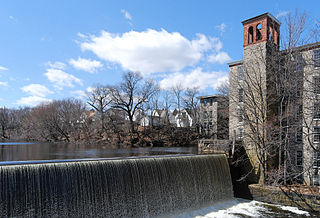
The South Branch Pawtuxet River is a river in the U.S. state of Rhode Island. It flows approximately 9.8 miles (15.8 km). There are 11 dams along the river's length.

Bristol County Jail is a historic jail at 48 Court Street in Bristol, Rhode Island and home to the Bristol Historical and Preservation Society.

The Arkwright Bridge is an abandoned historic bridge formerly carrying Hill Street over the Pawtuxet River in the Arkwright mill village in central Rhode Island. The river forms the border between Cranston and Coventry.
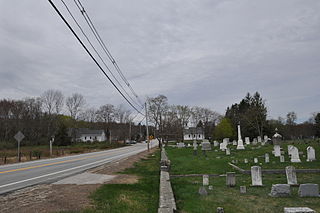
The Moosup Valley Historic District is a rural, agricultural historic district in western Foster, Rhode Island. The focal center of the area is a small village where Moosup Valley Road crosses the Moosup River, and where the Moosup Valley Christian Church is located. The largest concentration of buildings in the district lie along a roughly one-mile stretch of Moosup Valley Road west of Rhode Island Route 14, with properties extending along some of the winding roads that extend from that road. The district encompasses most of the headwaters of the Moosup River. The major public buildings are the church, a vernacular Greek Revival structure built in 1864–65, and the Grange hall, built in 1926. There is also a one-room schoolhouse which was built in 1811, and later used as a library and community center.
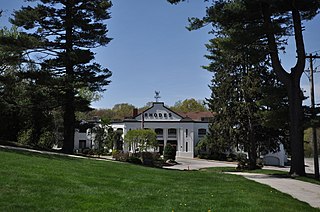
Rhodes-on-the Pawtuxet is a historic recreational complex at Rhodes Place, on the Pawtuxet River in Cranston, Rhode Island. Originally consisting of a series of buildings, including a stateroom, pavilion, and waterfront facilities, today only a ballroom and gazebo survive. The ballroom is a Classical Revival building designed by architects John F. O'Malley and Harry A. Lewis and built in 1915, after the entire complex, except for the stateroom and gazebo, was destroyed by fire. The stateroom burned in 1977. The gazebo was built c. 1880, and has long been a local landmark, with trademark Queen Anne scrollwork and turned corner posts.

St. Joseph's Roman Catholic Church is a historic church at 86 Hope Street in Providence, Rhode Island within the Diocese of Providence.

The Hope Village Historic District is a historic rural mill settlement within Hope Village in Scituate, Rhode Island. Hope Village is located on a bend in the North Pawtuxet River in the southeastern corner of Scituate. Industrial activity has occurred in Hope Village since the mid-eighteenth century. Surviving industrial and residential buildings in the Historic District date back to the early 19th century. The village center sits at junction of Main Street and North Road. Hope Village radiates out from the center with houses on several smaller side streets in a compact configuration. Currently there is little commercial or industrial activity in Hope Village and none in the Historic District. The present stone mill building on the south side of Hope Village was built in 1844 by Brown & Ives of Providence, expanded in 1871 and modified in 1910. Approximately one quarter of the village's current housing stock was built as mill worker housing by various owners of Hope Mill.

The Centreville Mill is an historic textile mill at 3 Bridal Avenue in West Warwick, Rhode Island. The mill complex is located on a site that has been used for textile processing since 1794, only four years after Samuel Slater's successful mill operation was established in Pawtucket. The oldest surviving buildings on the east side of the Pawtuxet River date to the 1860s.

The Crompton Mill Historic District is a historic district encompassing a mill complex at 20 Remington Street, 53 and 65 Manchester Street in West Warwick, Rhode Island. The mill complex consists of a collection of mainly brick buildings, bounded by the Pawtuxet River and Pulaski, Remington, and Manchester Streets in the village of Crompton. The mill complex formerly extended across the river, but the complex on the west bank was destroyed by fire in 1992. The oldest elements of the complex are the dam site and some of the raceways that provided water power to the mills. The present dam was built in 1908, replacing an 1882 structure. The raceways were built in 1807, around the time of the first mill buildings. The stone Mill No. 1, built 1807, is believed to be the oldest stone mill building in the state. Most of the complex's buildings were built in the late 19th and early 20th centuries by the Providence Manufacturing Company and its successors. The mill was used for textile processing until 1946, when the Crompton Corporation ended production.
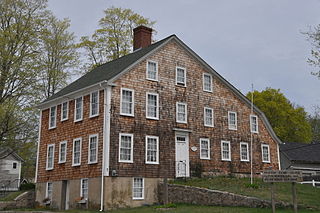
The Paine House Museum is an historic house at 7 Station Street in the village of Washington in the town Coventry, Rhode Island. The oldest portion of this large 2+1⁄2-story wood-frame house may have been built as early as 1691 by Samuel Bennett, who was known to operate a sawmill on the nearby Pawtuxet River. The house was significantly enlarged c. 1748 by Francis Brayton. His son, Francis Jr., was granted a license to operate a tavern on the premises in 1785. The property was acquired by the Paine family in 1866, whose descendants gave it to the Western Rhode Island Civic Historical Society in 1953.

The Pawtuxet Valley Dyeing Company was a historic mill complex at 9 Howard Avenue in the town of Coventry, Rhode Island. The complex included three buildings: the main mill building and two pump houses, as well as the dam which impounds the Pearce Mill Pond, and the tailrace which evacuates water from the mill into the North Branch Pawtuxet River.
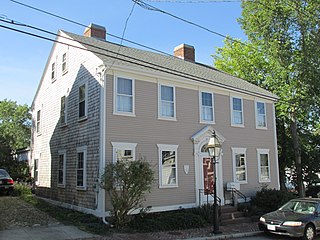
The Christopher Rhodes House is an historic house at 25 Post Road in the Pawtuxet village of Warwick, Rhode Island. The 2+1⁄2-story timber-frame house was built c. 1800 by Christopher Rhodes, a prominent local businessman and cofounder with his brothers of the Pawtuxet Bank. The house was probably one of the finest Federal style homes of its time in the village, and is now one of the few to survive from that time. It has a side-gable roof, and is five bays wide with a center entry. The entry is topped by a fanlight and moulded architrave, and framed by Ionic pilasters.
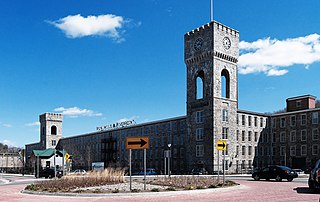
The Royal Mill Complex is an historic textile mill site at 125 Providence Street in West Warwick, Rhode Island. The mill complex was listed on the National Register of Historic Places in 2004. It has recently been completely renovated and remodeled into 250 residential apartments. The complex also includes the Ace Dye Works mill on the south side of the river, which has been converted into lofts. A pedestrian skybridge connects the two mills.

The Harris Mill, also known as the Interlaken Mills, is a historic mill complex at 618 Main Street in the Harris village of Coventry, Rhode Island. This complex of ten buildings occupies a 4.3-acre (1.7 ha) parcel adjacent to the North Branch of the Pawtuxet River. The oldest portion of the main mill building dates to 1850, with a major expansion added in 1870. The mill was founded by Elisha Harris, who had recently served as Governor of Rhode Island, and produced cotton twill cloth. It was acquired by Interlaken Mills in 1900, for whom it had been a major supplier, and was operated until 1953. In 2014, the long abandoned mill was restored and renovated into an apartment complex.
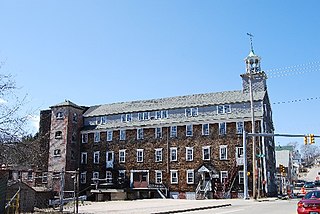
Lippitt, Rhode Island is a village within the town of West Warwick, Rhode Island.

Anthony is a village along Route 117 within the town of Coventry, Rhode Island near the villages of Washington and Quidnick on the southwestern banks of the Pawtuxet River. The village comprises "Anthony, Arnold, Boston, Mapledale, Meeting, Taft, Washington and Laurel Avenue."
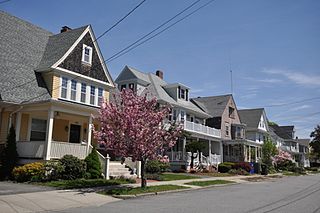
The Edgewood Historic District–Sally Greene Homestead Plats is a residential historic district in the Edgewood neighborhood of eastern Cranston, Rhode Island. Bounded by Glen Avenue to the north, Broad Street to the west, Massasoit Street to the south, and the Providence River to the east, this area was developed between 1900 and 1963 as a streetcar suburb for middle and lower middle class residents on what was once a country estate. The district was listed on the National Register of Historic Places in 2016.






















